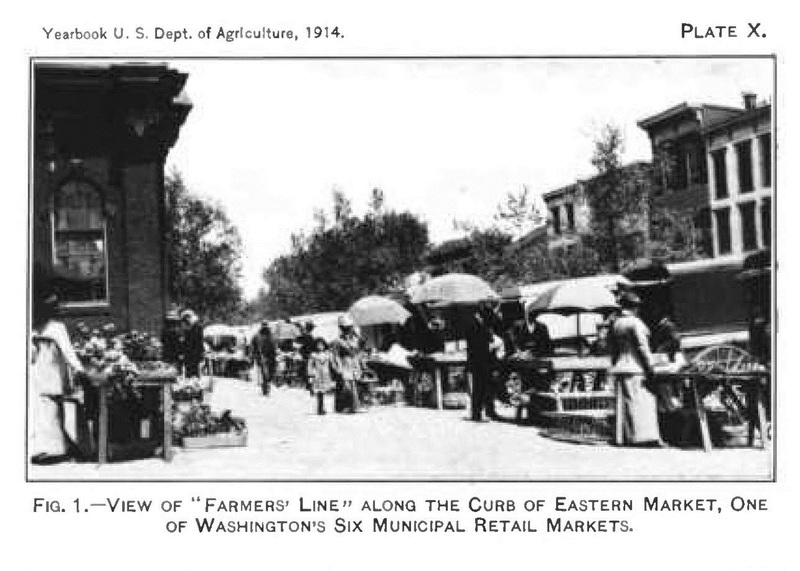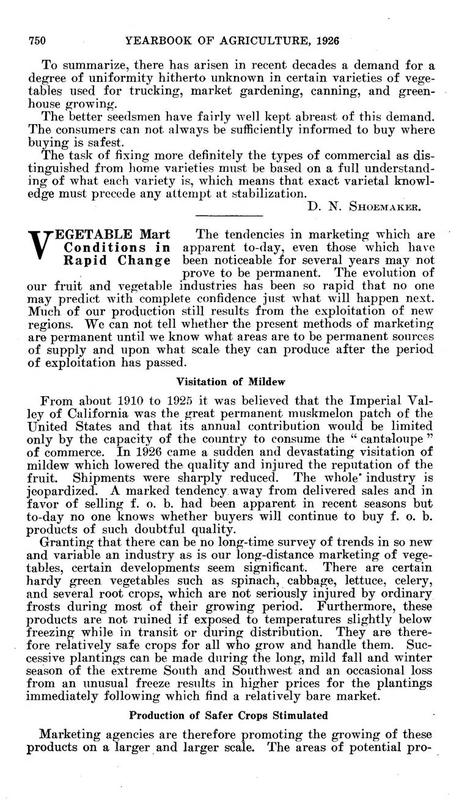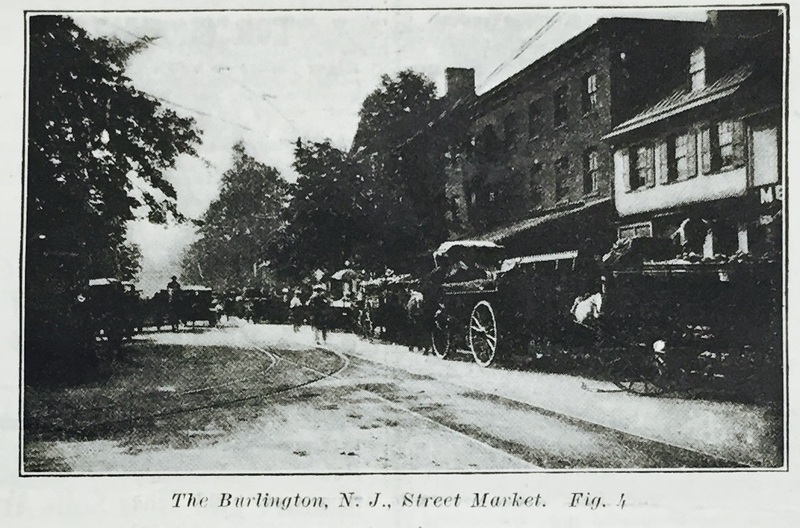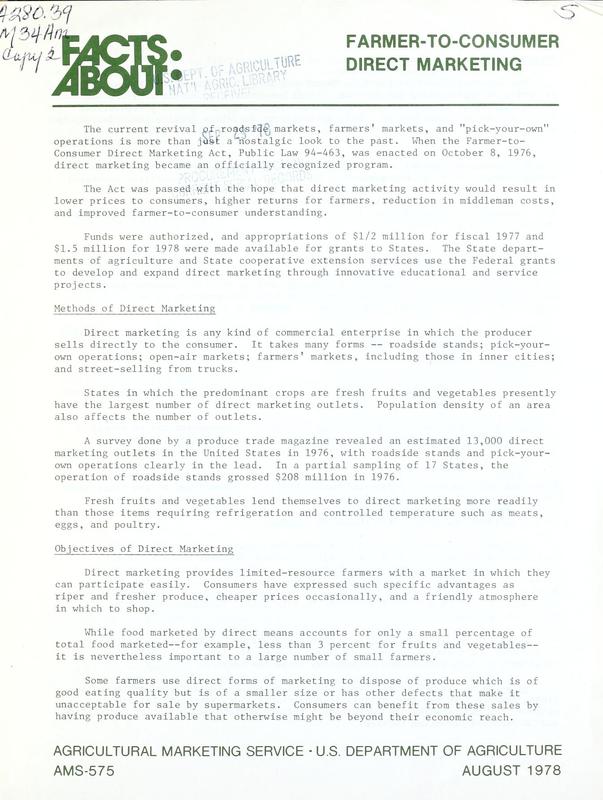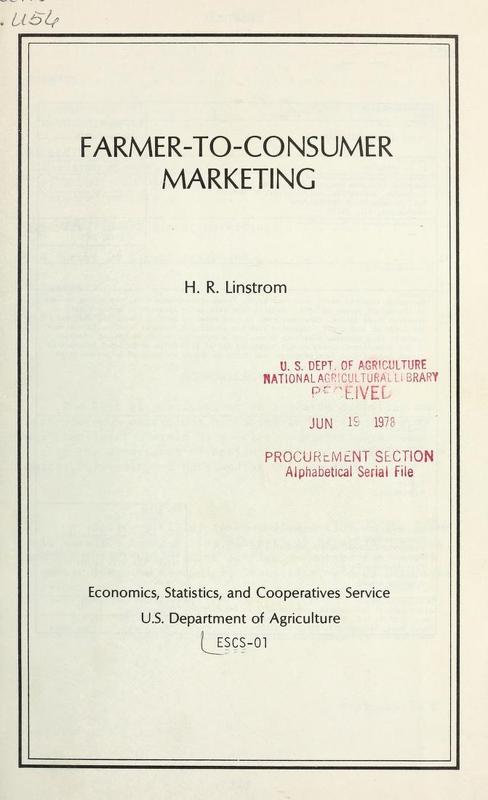Farmers Markets
The nature of farmers markets has changed over time, and the producer-only retail farmers market of today was uncommon until recently. In earlier times farmers markets mingled producers and resellers, but the function of markets has changed, the definition has become more categorical, and various restrictions on reseller participation have been instituted. Yet, regardless of these changes, all definitions of farmers market embrace the idea that several farmers selling their own products are vendors in a periodic marketplace. p. 658
The increase in the number of retail farmers markets in the first half of the twentieth century and the greater volume of produce they carried historically were linked to the demands of an increasingly urbanized population (Wann and others 1948)*. In 1946 the number of markets, the business they handled, and the amount of money moving through them were increasing. But the character of the markets was changing with national dietary preferences. Before improved transport, fresh fruits and vegetables were produced locally and were available only on a seasonal basis. In winter, only sturdy products such as “apples, potatoes, onions, pickles, sauerkraut, and some dried fruits were to be found (Wann and others, 1948, 7). Yet consumers still wanted fresh produce. As transportation and postharvest handling improved, fresh products could move from areas of off-season production to sites with unfulfilled consumer demand, exploiting market niches. Long-distance marketing necessitated assembly and brokerage functions that largely excluded farmers local to the consumption site. Similarly, slaughtering and meatpacking could be centralized with the development of refrigerated transport. p. 668
Brown, A. (2001) "Counting Farmers Markets," Geographical Review, 91(4)
-
Retail Farmers Markets...Then
Is the Public Market a Good Civic Investment? (1931). Sherman, Caroline Baldwin. U.S. Department of Agriculture. Leaflet Number 73
"Buying habits of the local consumers are an important factor. They must be studied to ascertain certain facts: (1) Whether food purchases are made chiefly on credit or for cash; (2) to what extent delivery is demanded; (2) to what extent the residents are willing to take home their own purchases, on foot, on street car or bus, or in the family car; (4) whether the housekeepers or the family buyers consider time and convenience as worth more than small savings and possible greater freshness of product; (5) whether those who expect to buy at the new market are leaders among various groups in the community so that their expenditures are likely to be considerable and their influence likely to bring other purchasers; (6) whether, if the interest is limited chiefly to those of small incomes, the numbers of this group are large enough to insure sufficient trade.” p. 5-6
Farmers’ Produce Markets in the United States: Part 1: History and Description (1946). Wann, John L. Cake, Edwin W., Elliott, William H., and Burdette, Roger F. Marketing Research Report Number 17
"With regard to the methods of selling at farmers' markets, the change has not been one of complete disappearance of one method in favor of another as much as it has been the introduction of new methods that have become popular along with the older methods. When farmers' markets were first established in the United States, all of them were retail markets where farmers sold only those products produced on their own farms. Today, even though there are many more retail markets than wholesale, the latter handle a greater volume of business. New types of farmers' markets also have developed. There are now four distinct kinds of farmers' produce markets which can be further classified into sub-types. These classifications are covered more fully in a later chapter.
The shift in importance from retail to wholesale methods of selling has been an evolutionary process which has been accelerated by the following factors: (l) Growth in urban population; (2) improvements in transportation and refrigeration; (3) the trend from diversified to specialized agricultural production; (4) the development of specialized farming areas at a great distance from the market, and (5) the emergence of the wholesale dealer. It is difficult in many instances to determine just how much effect each of these factors has had upon changes in marketing methods. However, all of these factors have been associated with the trend of selling a larger and larger proportion at wholesale. The increase in population of urban centers naturally led to the expansion and extension of the area from which these people obtained their food supplies. Improvements in transportation and refrigeration made it possible to extend the production areas still farther from the consuming centers. Inasmuch as some areas were better adapted to the growing of certain crops than others, specialized crop production soon developed at a great distance from the market. Since it was impossible for a farmer several hundred miles from the market to sell his products on the market in person, it was only natural that some agency would emerge to perform this function.
In spite of these changes in specialized areas and in certain crops, the farmers' produce market continues to be the most important source from which some cities obtain their fresh fruits and vegetables during at least a part of the year. In some instances there are still efficient production areas for truck crops located near the large urban centers. Where these conditions exist, growers still sell large volumes at farmers' retail markets. However, many farmers have discovered that they can make higher net returns by devoting more of their time to production and then selling at wholesale on a farmers' produce market rather than spending long hours in the market selling direct to consumers.” p. 9
Open Types of Public Markets (1921). Kerbey, McFall U.S. Department of Agriculture. Bulletin Number 1002
“From the point of view of the producer the function of public markets is to furnish an easily accessible place where there is a considerable demand for his goods and where at relatively slight expense he can personally conduct sales. A properly operated public market makes possible the free interaction of the' forces of supply and demand and places the operation of such forces more or less under the observation of the producer, and so furnishes one of the best possible opportunities for arrival at -a fair "market price.*' When producers peddle their wares from house to house or store to store their opportunities to judge the fairness of prices offered are obviously poorer than when they sell on a properly operated public market.
From the point of view of consumers who wish to patronize public markets their function, when properly operated, is to make available for choice larger quantities of fresher produce than can be found at ordinary stores, at lower prices, and in some cases under more satisfactory sanitary conditions. In addition to looking to markets to furnish lower prices themselves, consumers also see in such agencies a force which tends to bring about an indirect reduction of prices throughout the community by furnishing an active competition.
From the point of view of the community, properly operated public markets perform more fundamental functions in addition to those mentioned. By furnishing trustworthy outlets for miscellaneous food products they tend to encourage the farmers of the vicinity to produce more; they tend to help solve the city's problem of making available an adequate food supply at reasonable cost, so as to keep at home a greater proportion of the money spent by the citizens for food; and in general they tend to increase prosperity and improve living conditions, both in the city and in its immediate trade territory.” p. 3-4
Retail Public Markets (1915). Branch, G.V. Yearbook of Agriculture, 1914, pp. 167-184
"The success of a public market often depends upon the size and character of its "farmers' line" (Pl. X, fig. 1). There seems to be an innate desire on the part of housewives to buy from the producer and in the open. Consequently it behooves a city to study the tributary rural population. If a good truck-growing section is already developed within driving distance, there should be no trouble about lack of supplies for the market, unless the growers produce their crops in such large quantities that they are forced to sell at wholesale. If there is little truck growing in the region, however, methods of encouraging the farmers to take up that work should be employed. Such an outlet for products as a good public market creates is, in itself, an incentive to growers to engage in truck-crop production and usually aids greatly in developing a near-by food supply." p. 171
Methods and Costs of Marketing (1910). Andrews, Frank Yearbook of Agriculture, 1909, pp. 161-172
“Public market places are established in a number of cities and towns and in these places consumers may buy such articles as fruit, vegetables, dairy products, poultry, and eggs direct from farmers as well as from dealers. In recent years there has been a tendency in some markets, such as at Baltimore, Norfolk, and Washington, for practically all of the stalls to be used by dealers, while the producers occupy places along the neighboring sidewalks.” p. 165
Vegetable Mart Conditions in Rapid Change (1927). Sherman, Wells A. Yearbook of Agriculture, 1926, pp. 750-752
“In spite of considerable discussion and some legislation in its favor the farmer's retail market does not appear to be growing in importance. Where these markets are well patronized they furnish an outlet for many fresh, ungraded products which can not be shipped profitably for long distances. Itinerant motor-truck operators also can dispose of much ungraded produce, for the purchaser is not prejudiced by a comparison of qualities. Aside from these outlets, however, the local producer will find careful grading increasingly necessary.” p. 752
Suggestions For An Ordinance To Establish, Locate, Regulate, And Maintain A Public Farmers’ Market, And For Other Purposes (1921). U.S. Department of Agriculture. Bureau of Markets and Crop Estimates. USDA Service and Regulatory Announcements 69
“Who should be permitted to sell on the market will depend on a number of considerations, such as whether a large assortment of products are produced on adjacent farms, whether the primary purpose of the market is to assist producers, or whether convenience of consumers is of paramount importance. The presence of hucksters on a market broadens the variety of its products, as such vendors deal in tropical fruits and other shipped-in products.
It is well to prevent on a public market any taint of speculation by one farmer in products of other farmers, and it therefore seems desirable to restrict sales of other produce than that raised by those making sales, except where definite and limited exceptions are made, such as where sales are for accommodation or in the case of hucksters.
When hucksters are permitted to sell on a public market they usually are prohibited from reselling products bought on the market and from selling outside products which compete directly with those produced by the local farmers. In recognition of the fact that their markets are primarily for producers, and to avoid misleading consumers, some communities consider it desirable to place the hucksters admitted to the market in a separate, labeled section. Another possibility is to provide each actual producer (for a fee) with a sign or badger certifying that he is a producer.” pp. 12-13
A Real Farmers' Market: Successful Enterprise in a New Jersey Town (1920). Andrews, F. Rural New Yorker, 79, p. 5
“OPEN AIR SALES.- A unique farmers’ market is being operated in the city of Burlington, N.J., located along the Delaware River in Burlington County, and about 18 miles from Philadelphia. Here the farmers haul in their produce on Mondays, Wednesdays and Saturdays, and sell direct to the consumers. The farm wagons are lined along both sides of the main street for several blocks, often branching off into side thoroughfares, and the selling is done out of the wagons to the buyers on the curb. Two trolley lines run on the street used by the farmers, which together with the usual market traffic, necessitates the presence of traffic officers on this busy thoroughfare during the market sessions. This market begins early in the morning and lasts until noon, at which time all of the farmers have readily disposed of their product.” p. 5
Facts About: Farmer-to-Consumer Direct Marketing (1978). U.S. Department of Agriculture. Agricultural Marketing Service. Agricultural Marketing Service Report Number 575
"The current revival of roadside markets, farmers’ markets, and 'pick-your-own' operations is more than just a nostalgic look to the past. When the Farmer-to-Consumer Direct Marketing Act, Public Law 94-463, was enacted on October 8, 1976, direct marketing became an officially recognized program.
The Act was passed with the hope that direct marketing activity would result in lower prices to consumers, higher returns for farmers, reduction in middleman costs, and improved farmer-to-consumer understanding." p. 1
Farmer-To-Consumer Marketing (1978). Linstron, H.R. U.S. Department of Agriculture. Economics, Statistics, and Cooperatives Service
“Farmers’ markets are one of the oldest methods of direct marketing. They are more formalized, and possibly more permanent, than the other direct-marketing operations. They are located in either publicly or privately owned market places where a grower rents space in which to display and sell produce. Most students of direct marketing say that farmers’ markets are increasing in number across the country. Although an accurate count is not available, there were an estimated 541 farmers’ markets in 36 states and the District of Columbia in 1976. For the entire United States, the number probably approached 600.” p. 9
-
Retail Farmers Markets...Now
Farmers Marketing: Direct sales through markets, roadside stands, and other means up 8 percent since 2007 (2014). Agriculture Census Highlights (ACH) - 7. U.S. Department of Agriculture, National Agricultural Statistics Service
"Throughout the United States, 144,520 farms sold $1.3 billion in fresh edible agricultural products directly to consumers in 2012. This was a 6 percent increase in farms, and an 8 percent increase in sales, over 2007, the last time the agriculture census was conducted. Farms with direct sales to consumers were 6.9 percent of the nation’s 2.1 million farms in 2012, but those sales accounted for only 0.3 percent of total agriculture sales." p. 1
Farmer-To-Consumer Marketing (2010). Martinez, Steve, Hand, Michael S., Da Pra, Michelle, Pollack, Susan, Ralston, Katherine, Smith,Travis, Vogel, Stephen, Clark, Shellye, Lohr, Luanne, Low, Sarah, and Newman, Constance. Economic Research Report (ERR) Number 97
“The number of farmers’ markets grew to 5,274 markets in 2009, a 92-percent increase from 1998 (USDA, AMS, 2009) (fi g. 1). They are concentrated in densely populated areas of the Northeast, Midwest, and West Coast (fi g. 2). According to the USDA Agricultural Marketing Service’s 2006 National Farmers’ Market Survey, the most popular product category sold at farmers’ markets was fresh fruits and vegetables, which was sold by nearly 92 percent of farmers’ market managers in 2005, followed by herbs and flowers, and honey, nuts, and preserves (Ragland and Tropp, 2009). However, not all products sold at farmers’ markets are part of the local food system (Hughes et al., 2007). For example, some vendors may come from outside the local region, and some local vendors may not sell products that are produced within the region.” p. 6
Opening a Farmers Market on Federal Property: A Guide for Market Operators and Building Managers (2009). U.S. Department of Agriculture. Agricultural Marketing Service, Beach, Karen, Giblin, Frank, and Lakins, Velma
“Throughout the United States, the number of farmers markets continues to rise, their popularity spurred by consumers’ growing demand for locally produced food. More than 4,900 farmers markets operate nationwide today—a jump from fewer than 1,800 only 15 years ago. In addition to providing easier access to fresh food, studies show establishing a farmers market can revitalize a neighborhood, enhance social interaction, improve the local economy, and provide a supplemental source of farm income for many growers.
Moreover, because farmers markets increase the availability of fresh fruits and vegetables for consumers, they play an important role in the Government’s mission to combat childhood obesity. The United States Department of Agriculture (USDA) has operated a farmers market at its Washington, D.C., headquarters since 1996. (For more information, see “Market Successes” at the end of this guide.) USDA also supports farmers markets through additional programs managed by several USDA agencies. The Agricultural Marketing Service (AMS), for example, awards grants, offers technical assistance, and helps with marketing and promotion.” p. 1
Improving and Facilitating a Farmers Market in a Low-Income Urban Neighborhood: A Washington, DC, Case Study (2001). U.S. Department of Agriculture. Agricultural Marketing Service. Transportation and Marketing Programs. Wholesale and Alternative Markets.
“The Anacostia Farmers Market was a project initiated by the From the Ground Up (FGU) program of the Capital Area Food Bank (CAFB). The CAFB recognized a profound lack of healthful food choices in retail outlets in the Anacostia neighborhood, especially fresh produce. The CAFB began the farmers market project to address the problem.
The ultimate goal for the CAFB farmers market project is to provide support and management until it can be sustained economically by the community. By providing an outlet for local fresh produce to the residents and business people of the Anacostia neighborhood, the CAFB seeks to combat hunger and malnutrition in the community and create a new market for local farmers and neighborhood entrepreneurs. The Anacostia Farmers Market can also provide the community a space to gather and communicate on issues of concern.” p. 4
Direct Farm Marketing as a Rural Development Tool (1997). Gale, Fred Rural Development Perspectives, 12(2), pp. 19-25
“Farmers’ markets are, of course, the oldest and most common type of direct selling. A 1993 directory of farmers’ markets published by the USDA listed 1,755 operating markets. The total number of farmers’ markets may actually be much larger, since this was not an exhaustive list and probably excluded many smaller markets. Marketing specialists at USDA and land-grant colleges believe that the number of farmers’ markets is growing, although there are no historical statistics for comparison. Markets vary widely. Some are year-round, others are seasonal; some are held in permanent indoor facilities, others are held in parking lots.” p. 20
 An official website of the United States government.
An official website of the United States government.





